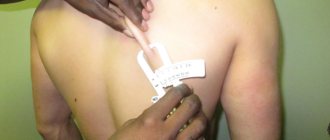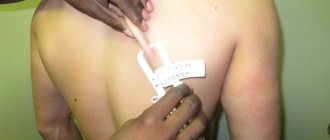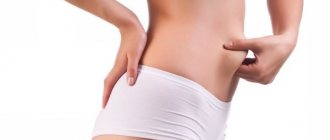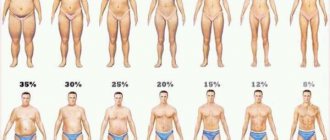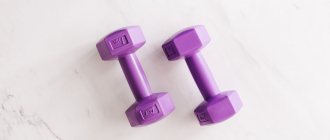How to calculate body fat percentage? Why do you need to know your body fat percentage? We'll figure it out together with a trainer and an endocrinologist.
The number on the scale is far from the most important indicator of physical fitness. The ratio of fat to muscle mass is what really matters. We will tell you below how to correctly assess your body composition.
Alexander Kozhevnikov
trainer, rehabilitation specialist, nutritionist
The higher the percentage and amount of fat in the body, the higher the risk of developing complications and diseases of the cardiovascular system, musculoskeletal system and endocrine system.
How to find out your fat percentage?
There is no exact way to say this with 100% success. There are more accurate methods, there are simple methods that show this approximately.
Identification from photographs
The fastest and easiest way. To determine your body fat percentage, you need to find a body shape that is as similar to yours as possible.
Cost: free. Pros: fast, free. Cons: requires your assessment of yourself, which is not always objective. We may unconsciously “throw off” a few pounds in our minds and compare ourselves to the slimmer version in the photo.
Using a caliper
A caliper is a special device that measures the thickness of the skin-fat folds in different parts of the body. Based on the obtained figures, the percentage of fat is determined using special tables or formulas.
Method number 1: measurements for women
1. Back of the shoulder: the fold is taken vertically in the middle between the shoulder joint and the elbow.
2. On the side: the fold is taken from the side diagonally in the middle between the lower rib and the hip bones.
3. On the stomach: the fold is taken vertically at a distance of +-2.5 cm away from the navel.
We calculate the percentage of fat using the formula:
% fat = (A-B+C) + 4.03653 , where:
A = 0.41563 x (sum of all three folds in mm)
B = 0.00112 x (sum of all three folds in mm squared)
C = 0.03661 x age in years
Method No. 2: measurement for women and men
We add the resulting numbers in mm and find out the percentage of subcutaneous fat using the table:
Cost: 500-800 rubles per caliper. Pros: fast, you can do it yourself at home, fairly accurate indicators. Cons: you need practice to learn how to use it correctly or someone else's help, calculations using formulas are required.
Bioimpedance analysis
A weak current is passed through the body using electrodes attached to the ankles and wrists, after which the electrical resistance of the tissue is measured. The method is based on the fact that fat mass and the rest of the “dry” body mass have different resistance.
Cost: 1000-3000 rubles in private clinics or free under the compulsory medical insurance policy in public health centers. Pros: fast, does not require any activity. Cons: price, need to visit a clinic, use of equipment of varying quality. Not always accurate indicators, since the figure may be affected by water balance (edema).
Scales with fat percentage analyzer
The principle is the same as in bioimpedance: the device passes a weak current through you and calculates tissue resistance.
Cost: 2500 - 10,000 rubles Pros: fast, suitable for regular home use. Disadvantages: the same as for bioimpedance - price, not always accurate indicators, since the figure can be affected by water balance (edema). When repeated measurements, fluid loss may show on the scale a decrease in the percentage of fat mass, although in fact it has remained unchanged.
Underwater weighing method
The method is based on Archimedes' law: a solid body immersed in water loses as much weight as the liquid it displaces. Since dry body mass and fat mass are different in density, the percentage of fat mass is determined by comparing body density after regular weighing and underwater weighing. The method is complex and rarely used.
Cost: could not be found out Pros: the most accurate method to date. Cons: Duration 45-60 minutes, difficult procedure and likely high cost. Fear of underwater diving.
Determination by body mass index from Lyle MacDonald
The method is only suitable for untrained people, i.e. for beginners who have not yet started strength training. For the lucky owners of visible muscles built in the gym beyond the “norm”, this method is not suitable.
To determine your body fat percentage, you need to know your body mass index.
BMI = weight in kg/height in square meters
For example: 50/(1.64*1.64)=18.5. Next, use the table in the picture and find your match:
What does body fat percentage mean?
Body fat percentage is considered to be the proportion of fat relative to total body weight. The trainer notes that these indicators differ for men and women and depend on age, eating behavior and the functioning of the hormonal system.
| 10-20 years | 20-40 years | 40+ years | |
| Men | 11-22% | 13-24% | 15-28% |
| Women | 16-27% | 18-29% | 20-35% |
According to the expert, there are also lower limits of normal body fat, beyond which it is better not to go. For men it is 4-7%, for women - 10-12%. Otherwise, there is a risk of provoking hormonal disorders, eating disorders and “rebellion” of the body, which will require you to return “every cent” to it. And there are reasons for this.
Since fat is one of the sources of energy, adipose tissue is needed for the normal functioning of the body, says the endocrinologist. It protects internal organs from mechanical damage and serves as a protective layer between the skin and muscle tissue. But its functions are not limited to this.
Julia Kathuria
endocrinologist, doctor at the European Medical Center
Adipose tissue is an endocrine organ that synthesizes a variety of biologically active substances. For example, it produces hormones. It can also produce cytokines or messengers that transmit information from cell to cell - this is necessary for the regulation of allergic, immune, autoimmune and other reactions. Any change in the amount of adipose tissue - both deficiency and excess - leads to disruption of the production of a number of substances, and this can cause metabolic abnormalities.
Experiment: checking why training according to a general program is ineffective
How to determine that muscles are “losing weight”?
Features of fat cell breakdown
The fat itself is located in adipocytes or fat cells. To extract it from there, it must be transformed into fatty acids and glycerol. To begin the breakdown process, you need to reduce the level of fatty acids in the blood (through diet) or increase the concentration of ATP breakdown products (through sports), which supply energy reserves and require fatty acids for their formation. We are not talking about glycerol now. Once in the blood, fatty acids move along with proteins and albumins. Their quantity determines blood viscosity and albumin content. This is another factor to consider when losing weight quickly.
Fatty acids are partially consumed for ATP energy resources with the participation of muscle contractions. Muscle activity promotes the utilization of fatty acids. At the end of the acid breakdown process, carbon dioxide and water are formed. After decomposition, water exceeds fatty acids by mass by 7.5 times. Thus, if you lose no more than 500 grams of fat per week, then it is safe. If, say, 1.5 kg of it per week is lost, then the volume of blood per day should increase by 1.5 liters. In total, a person has about five liters of shelter, so the increase will be 30%. And the additional liquid formed when burning fat passes through all vessels, loading the heart, kidneys, and internal organs. If fats are burned very quickly, this leads to severe wear and tear on the heart and kidneys. And this is another factor against rapid weight loss.
If weight loss occurs only through dieting, without sports, then this is also not the best scenario. Accelerating the weight loss process leads to an increase in the concentration of fatty acids in the body, increasing the risk of cholesterol deposits in blood vessels. If the muscles do not burn fat, it penetrates the liver and puts too much strain on it. Over the course of several strict diets, the liver can become heavily filled with fat cells and become a fatty organ, which provokes cirrhosis of the liver. Physical activity will help prevent fats from entering the liver. The diet should have enough protein, which takes part in the formation of muscles, which take an active part in the utilization of fat. It is also important that the body receives enough vitamins. It is useful to consume fish oil and flaxseed oil, which help normalize metabolism.
Now you know how many calories are in one kg of human fat, and how the process of burning this substance occurs. Remember that fat loss should be safe and moderate. It is important to listen to your body and not overdo it.
Why determine your body fat percentage?
Your body fat percentage reflects your progress in both losing weight and gaining muscle mass. And in general, this is a good way to monitor your health. And that's why.
The higher the percentage and amount of fat in the body, the higher the risk of developing complications and diseases of the cardiovascular system, musculoskeletal system and endocrine system, notes the endocrinologist.
You also need to measure the amount of fat in your body in order to make sure that you do not have problems with excess weight, and that the percentage of fat does not go beyond the lower and upper limits of its norm.
Photo: unsplash.com/@jasonyoder
Hormones of adipose tissue directly affect a person’s eating behavior, says the endocrinologist. The hormone leptin, which is produced with the help of fat, controls energy metabolism in the body, is responsible for the feeling of fullness and suppresses appetite.
How many calories are in a kilogram of human fat?
The answer to the question of how many calories are in human fat is 7716 kcal per kilogram. If we convert this value into pounds, we get approximately 3500 kcal per pound of subcutaneous fat.
One gram of pure fat contains 9 kilocalories. But why then is the number of calories in human fat different? The fact is that it is not fat in its pure form. It contains small amounts of water, connective tissue and other ballast compounds. These impurities are not taken into account when calculating fat in foods, but when calculating calories in a person’s subcutaneous fat, they need to be taken into account.
It follows that a gram of subcutaneous fat contains 7 kcal, and not the usual 9.
Knowing how many calories are in 1 kg of human fat, you can calculate how many calories you need to burn and consume to lose as much weight as you want. To lose weight, you need to create a calorie deficit, that is, spend more energy than you consume through food. Just create a difference of 500 kcal, and in two weeks you can lose a kilogram of pure fat.
If you create a calorie deficit of 1000 kcal daily, you can reduce the period of losing a kilogram of fat to one week. This is the speed that is still considered safe, but faster weight loss is fraught with negative consequences.
Please note that the express diets that are loved by many, through which you can lose a couple of kilograms in just 2-3 days, remove fluid from the body, which quickly returns when a person adheres to his usual diet again. Fat disappears later, and to get rid of it you need to regularly adhere to proper and moderate nutrition and exercise.
5) Impact your abs with special exercises
Exercises such as planks, bicycles, or hanging leg raises are extremely effective for the abs. Do different exercises, and as you progress, add some weight to your movements to make them even more effective.
For example, you can make the exercise heavier by simply placing dumbbells between your legs while performing reverse crunches. You can also add a plate to your hanging leg raise.
Critical fat content in the human body
With an increase in its percentage of muscle and bone mass, the risk of negative consequences from the body increases. In particular, unsafe factors appear such as:
- pressure surges;
- heart attacks of various types;
- diabetes;
- threat of cancer, etc.
However, it is worth noting: not only an excess of body fat is dangerous, but also a lack of it. The latter is extremely undesirable for women. So, with indicators below optimal:
- the skin becomes flabby;
- wrinkles appear quickly;
- hair becomes dull and split;
- reproductive function is lost;
- unwanted body hair occurs;
- bone fragility is observed;
- the risk of atherosclerosis increases;
- the regulation of cholesterol in the blood is disrupted.
If the fat ratio drops below 14 percent, the presence of male hormones begins to increase, since the female hormone estrogen is produced specifically by adipose tissue.
How to calculate body mass index?
Body mass index (BMI) is a measurement used to measure obesity. Body mass index is a ratio of a person's height to weight.
To calculate your BMI:
- measure your height and convert it to meters.
- Square the resulting value. Suppose your height is 180 centimeters or 1.8 meters, which squared will be 1.8 * 1.8 = 3.24.
- divide your weight by this result. For example, with a weight of 90 kg, height is 180 cm. Accordingly, BMI = 90: (1.8 × 1.8) = 27.7.
The resulting number is your body mass index.
There are 6 groups based on body mass index:
- low weight - up to 18
- normal weight - from 18 to 25
- excess weight (pre-obesity) - from 25 to 30
- obesity 1st degree - from 30 to 35
- obesity 2nd degree - from 35 to 40
- obesity 3rd degree - from 40 and above
Ensuring control
The most suitable solution is to focus on the average balanced volume, which allows you to track scales with a body analysis function. They instantly perform the necessary data calculations, comparing them with all entered indicators. At the end, they give you a real result, which can be taken as a basis to lose excess body weight through fitness or diets.
Whereas manual calculations based on individual information do not always reflect the state of affairs. Any formula will be correct only if the fat tissue is evenly distributed. Therefore, measurement using special scales is much more accurate and simpler.
Norms and indicators
Before we measure, let's understand what percentage of body fat is normal. And here we need to turn to doctors and biologists.
According to the recommendation of the Committee on Physical Culture and Sports, the normal fat level for women is 21-31%, for men - 14-25%.
As you noticed, the normal “fat percentage” for women is about 5% higher, and this is in line with WHO recommendations. This is due to the special female reproductive system and the functioning of the hormonal system.
Image source: www.fizkult-nn.ru
4) Don't waste time trying to remove fat from certain areas of the body
This is one of the most common myths in the fitness industry. You cannot lose fat only in a certain area of the body. However, you can train your muscles so that after you lose some fat, the area you focus on will be more toned.
This is where specific abdominal exercises come in handy. If you exercise regularly and watch your diet, you will find that your body fat decreases and ripped abs begin to appear.
6) Include challenging exercises in your training routine.
Compound exercises such as squats and deadlifts are multifunctional exercises and therefore work both the abs and the entire body.
These exercises require a lot of effort and are guaranteed to burn a lot of calories, so you can double the effect of burning calories and toning up in just one exercise!
Burning more calories leads to more fat loss later on, as long as you continue to watch your diet! In addition to burning calories, a big plus is that these exercises preserve lean muscle mass.
Lean muscle mass burns more calories at rest than fat and thus will also result in even more calories burned overall.
Muscle
Many men are now engaged in creating the torso of Apollo from their bodies. Pumped up biceps and buttocks have become a cult in our time. And it’s not surprising, aesthetics is important for a person in everything, and our body is no exception.
So, we have already found out that fat will not develop into muscle. Then where can you get them from?
It is known that muscles grow from physical activity. But it is not so. The muscles themselves do not grow, but only slightly increase in volume. Without certain nutrition, muscle tissue will not grow larger.
Pump fat into muscle?
People who are losing weight ask the question: “How to pump fat into muscles.” In fact, the answer may puzzle some. It is impossible to pump fat into muscles.
How so?
Yes, very simple. It's like turning the stomach into kidneys or the small intestine into a spleen. These are different organs and they cannot replace each other in any way. The same goes for fat and muscle. These are two different tissues that cannot transform into each other.
You will be interested in: Fitness bikini diet: diet options, goals, tasks, sample menu for the day and week, indications, contraindications, recommendations and reviews
You can lose weight and gain muscle mass! But everything is done in stages. First, a person needs to lose excess fat, and therefore accumulate the necessary muscle mass.
3) Lose fat with cardio
Cardio is a really useful tool to help you lose fat and make your abs visible. A popular and effective type of cardio training is HIIT, high-intensity interval training. This is actually a very good approach to cardio because thanks to such training you will be able to burn fat and at the same time maintain muscle mass.
Basically, you train very intensely, at your maximum, for a short time, then slow down and continue at a low intensity for the same amount of time or longer, depending on your fitness level. This technique is quick, and your fat continues to burn long after you go home. Typically completing five to ten intervals is an indicator of great performance!
